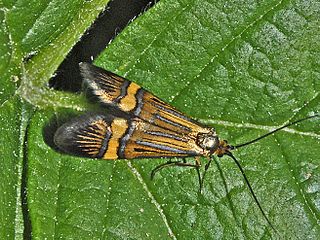
The longhorn moth or yellow-barred long-horn is a diurnal lepidopteran from the moths family Adelidae.

Cerura vinula, the puss moth, is a lepidopteran from the family Notodontidae. The species was first described by Carl Linnaeus in his 1758 10th edition of Systema Naturae.
Erbessa lamasi is a moth of the family Notodontidae first described by James S. Miller in 2008. It is found in south-eastern Peru.
Polypoetes copiosa is a moth of the family Notodontidae. It has a restricted distribution along the foothills of the Andes in western Ecuador.
Polypoetes corneola is a moth of the family Notodontidae. It is found in south-eastern Peru.
Polypoetes leuschneri is a moth of the family Notodontidae first described by Miller in 2008. It is endemic to the Pacific slope of the Ecuadorian Andes.
Polypoetes tulipa is a moth of the family Notodontidae. It is found in south-eastern Peru.
Polypoetes tinalandia is a moth of the family Notodontidae. It is found along the Pacific slope of the Ecuadorian Andes.
Polypoetes wagneri is a moth of the family Notodontidae first described by Miller in 2008. It is found in Costa Rica.
Polypoetes crenulata is a moth of the family Notodontidae. It is found in western Ecuador.
Polypoetes oteroi is a moth of the family Notodontidae. It is found in Venezuela.
Polypoetes bifenestra is a moth of the family Notodontidae. It is found in cloud forests in the Oriente of northern Ecuador at elevations between 2,000 and 3,000 meters.
Polypoetes sumaco is a moth of the family Notodontidae. It is found in eastern Ecuador.
Pareuchontha fuscivena is a moth of the family Notodontidae first described by James S. Miller in 2008. It is found in the western foothills of the Andes in Colombia.
Stenoplastis dyeri is a moth of the family Notodontidae. It is found on the eastern side of the Andes in Ecuador.
Syntypistis melana is a species of moth of the family Notodontidae first described by Chun-Sheng Wu and Cheng-Lai Fang in 2003. It is found in the Chinese provinces of Guangxi and Guizhou.

Disphragis notabilis is a moth of the family Notodontidae first described by William Schaus in 1906. It is found throughout the Amazon basin from western Venezuela east- and southward to at least Bolivia. The range includes French Guiana.
Xenomigia crenula is a moth of the family Notodontidae. It is found in north-eastern Ecuador.
Euclemensia barksdalensis is a moth in the family Cosmopterigidae. It was described by Lee and Brown in 2011. It is found in Louisiana.

Symmerista luisdiegogomezi is a moth in the family Notodontidae first described by Isidro A. Chacón in 2014. It has been collected between 2,450 and 2,600 meters in highland cloud forests dominated by Quercus trees in the foothills west of the Cordillera de Talamanca in southern Costa Rica.



